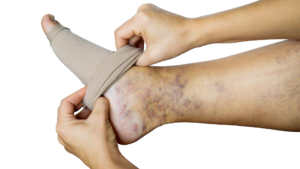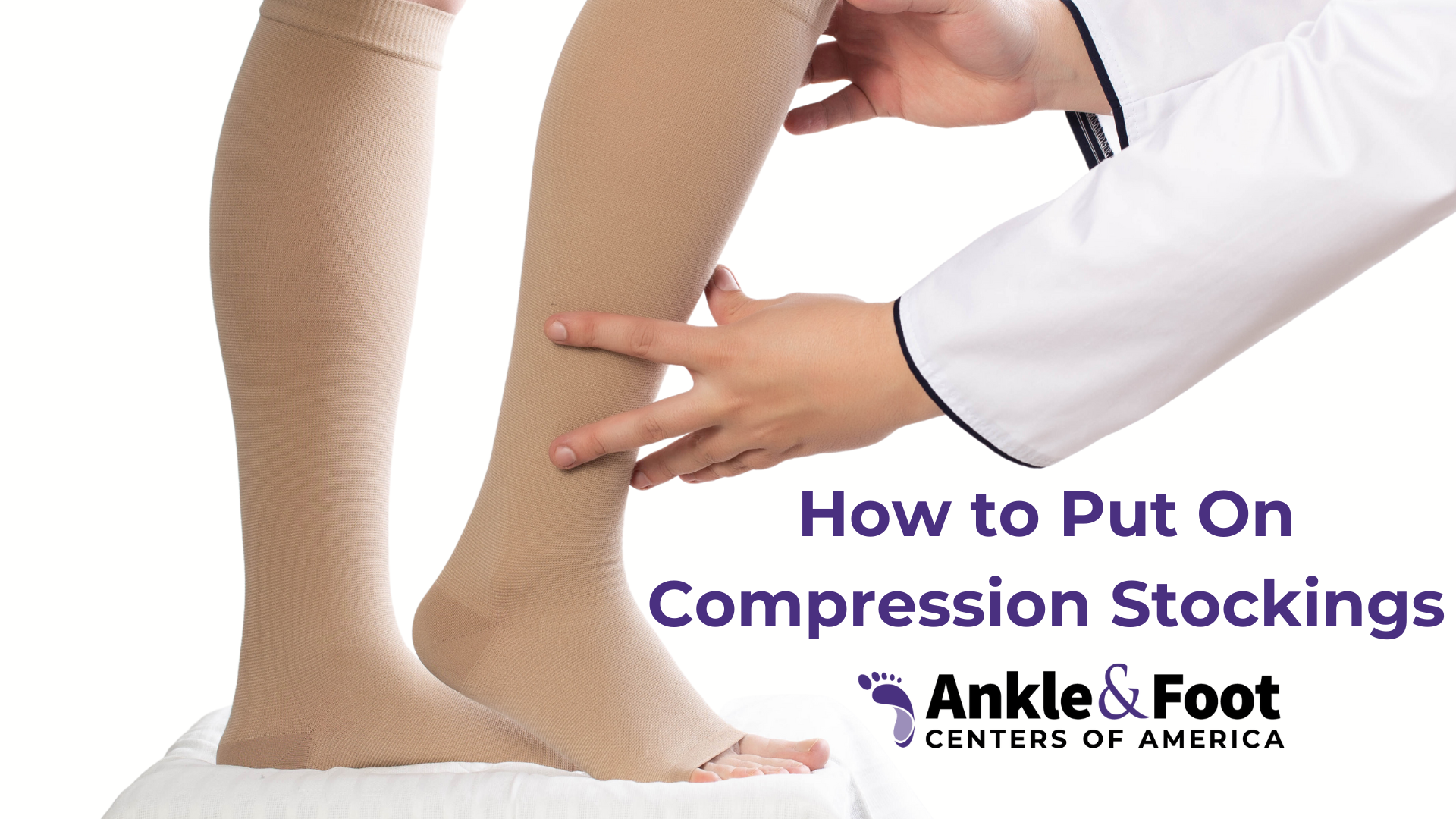Whether you’re an athlete looking to enhance performance and recovery, or a nurse spending countless hours standing, compression stockings are invaluable. Even during long-haul flights, these special socks can significantly decrease the risk of conditions like deep vein thrombosis (DVT). However, getting the most out of your compression stockings isn’t just about wearing them; it’s about wearing them right.
Understanding how to put on compression stockings correctly can ensure they work effectively, providing you the comfort and support you need. However, it can seem daunting and challenging initially, considering their tight fit. This comprehensive guide aims to demonstrate that, with the right steps and some useful tips, you can master the technique of putting on compression stockings, paving your way to healthier legs and a healthier you.
Table of Contents
Why Use Compression Stockings?
 Compression stockings are an essential tool in managing and preventing various health conditions, owing to their unique ability to apply ‘graduated’ pressure to your legs. This pressure is often highest at the ankle and gradually decreases as it goes up the leg. The design stimulates the circulation of blood and lymphatic fluid, providing a myriad of benefits.
Compression stockings are an essential tool in managing and preventing various health conditions, owing to their unique ability to apply ‘graduated’ pressure to your legs. This pressure is often highest at the ankle and gradually decreases as it goes up the leg. The design stimulates the circulation of blood and lymphatic fluid, providing a myriad of benefits.
Starting from performance enhancement and faster recovery in athletes, to alleviating discomfort and swelling in individuals who stand for long durations, these stockings have broad applications. They are particularly beneficial for people with certain medical conditions such as varicose veins, lymphedema, or deep vein thrombosis. By compressing the surface arteries and veins, they help circulate blood through narrower channels, enhancing arterial pressure and thereby causing more blood to return to the heart and less to pool in the feet.
Compression stockings also play a critical role in post-surgical care, especially for those with restricted mobility, as they help prevent blood clots. Moreover, for those who travel long distances, these stockings are helpful in mitigating the risk of developing DVT or leg swelling.
It’s worth noting that while compression stockings offer numerous benefits, it’s crucial to consult with a healthcare provider before using them, especially if you’re considering them for medical reasons. The right compression level varies based on individual needs and circumstances, and using them improperly can potentially lead to complications.
Understanding these benefits is the first step towards making the most out of your compression stockings. The next sections will guide you through the types of compression stockings, how to choose the right one, and ultimately, how to put them on correctly to reap these benefits.
Types of Compression Stockings
Not all compression stockings are made the same. Their construction is designed to cater to a range of needs and situations, making it important to know which type is most suitable for you.
Graduated Compression Stockings are arguably the most common type. They are designed to apply the greatest amount of compression at the ankle, gradually decreasing towards the top. They are usually knee or thigh-high and are often used to combat venous disorders and poor circulation.
Anti-Embolism Stockings also offer graduated compression but are designed for those who are immobile or post-surgical patients, providing a lower compression level compared to standard graduated stockings.
Nonmedical Support Hosiery such as flight socks or compression socks for runners are available over-the-counter and do not require a prescription. They provide uniform compression rather than graduated compression, making them suitable for people without a medical necessity but who may still benefit from improved circulation.
Each type of compression stocking offers its own set of benefits and uses, making it vital to understand which one will best suit your needs and lifestyle.
Choosing the Right Compression Stockings
Choosing the right compression stockings involves more than just picking the right type; you also need to consider the size and the compression level. Both of these factors are crucial to ensure comfort, effectiveness, and safety.

Sizing is critical when choosing compression stockings. Too large, and the stockings won’t provide the necessary compression. Too small, and they could restrict circulation instead of aiding it. You’ll need to take measurements of your legs to determine the correct size. Most brands provide a size chart which you can compare your measurements against to find the appropriate size.
The level of compression is measured in millimeters of mercury (mmHg), indicating the amount of pressure applied by the stockings. The right level for you will depend on your reasons for wearing them. For instance, for mild swelling or tired legs, a compression level of 15-20 mmHg may suffice. However, for more serious venous diseases, a healthcare provider may recommend a higher compression level.
It’s always a good idea to consult with a healthcare provider before deciding on the type, size, and compression level of the stockings. Once you’ve got the right pair, you’re ready to start benefiting from your compression stockings. The next step? Learning to put them on correctly.
How to Put on Compression Stockings: A Step-by-step Guide
Correctly putting on compression stockings can be a bit of a challenge initially due to their tight fit. However, with a bit of practice and technique, it becomes a simple routine. This section will guide you through a detailed, step-by-step process to put them on.
Preparing to Put on Your Stockings
- Inspect the Stockings: Before putting them on, ensure they are clean, dry, and without any tears or holes.
- Smooth out the Stockings: Unroll or unfold the stockings so they’re ready to be worn. Make sure there are no wrinkles.
- Prepare Your Skin: Make sure your skin is dry. If needed, apply talcum powder or a similar product to help the stockings slide on more easily.
Step-by-step Instructions
- Turn the Stocking Inside Out: Reach into the stocking and grab the heel or toe section, pulling it inside out, but leaving the foot part right side out.
- Put Your Foot Inside: Carefully insert your foot into the foot section of the stocking, making sure your heel is centered in the heel cup of the stocking.
- Roll or Pull the Stocking Up: Slowly roll or pull the stocking up your leg. Never pull at the top of the stocking, instead, work your way up gradually.
- Adjust for Comfort: Smooth out any wrinkles, and adjust the top band so it sits comfortably below the knee (for knee-highs) or on the upper thigh (for thigh-highs).
Tips for Easier Application
- Wear Rubber Gloves: Wearing rubber gloves can help you get a better grip on the stockings.
- Use a Stocking Donner: If you struggle to put on your stockings, consider investing in a stocking donner designed to make the process easier.
- Care for Your Skin: Keeping your skin moisturized can help the stockings glide on easier. However, avoid applying lotion right before putting your stockings on as it can make the skin slippery.

Caring for Your Compression Stockings
To maintain the effectiveness of your compression stockings, it’s vital to clean and care for them properly. Here are some general tips:
- Wash Regularly: After every use, wash your stockings with mild soap and warm water. Avoid using bleach or fabric softeners.
- Air Dry: Let your stockings air dry. Avoid wringing them out or tumble drying as it can damage the fibers.
- Handle with Care: When putting on or removing your stockings, be careful not to puncture or tear them with jewelry or long nails.
- Replace When Needed: Over time, the compression level of your stockings can decrease. It’s generally recommended to replace them every 3 to 6 months, depending on how often they’re worn.
Properly caring for your compression stockings can extend their lifespan and maintain their effectiveness. In the next section, we will explore potential side effects of compression stockings and how to minimize them.
Potential Side Effects of Compression Stockings
While compression stockings can offer numerous health benefits, like any treatment, they can potentially cause side effects. Most side effects are mild and can be managed by correctly using and caring for your stockings.
Common Side Effects

- Discomfort or Tightness: Compression stockings should feel snug but not uncomfortably tight. If they cause pain, it’s likely that they’re not the right size or compression level.
- Skin Irritation: Some people might experience itching or irritation, especially if they have sensitive skin or allergies to the stocking material.
- Indentations in the Skin: If the stockings are too tight, they may leave indentations or marks on your skin.
- Difficulty Putting On: Many people struggle to put on compression stockings at first due to their snug fit.
How to Minimize Side Effects
- Get the Right Fit: Ensure your stockings are the right size and compression level. If you’re unsure, consult a healthcare provider.
- Wear Them Correctly: Make sure your stockings are smooth against your skin with no bunching or wrinkles, which can cause discomfort or skin issues.
- Use a Donner or Application Aid: If you struggle to put your stockings on, a donner or other application aids can be helpful.
- Practice Good Skin Care: Keep your skin moisturized and in good condition. However, avoid applying lotion right before you put your stockings on, as it can make them more difficult to wear.
Remember, while these side effects may seem off-putting, with the correct fit and usage, compression stockings can offer substantial benefits. The next section will discuss when it’s best to wear compression stockings for maximum effectiveness.
When to Wear Compression Stockings for Maximum Effectiveness
The timing and duration of wearing your compression stockings can influence their effectiveness. Here are a few general guidelines to help you make the most of your stockings.
- Morning Application: It’s best to put your stockings on first thing in the morning before you get out of bed. This is when your legs are least swollen, which will make the stockings easier to put on and more comfortable to wear.
- Daily Wear: For most people, compression stockings are most beneficial when worn daily, especially if you’re using them to manage a chronic condition or prevent deep vein thrombosis.
- Duration of Wear: The length of time you should wear your stockings will depend on your specific needs and your healthcare provider’s recommendations. Some people may only need to wear them for a few hours each day, while others may need to wear them for the entire day.
- Remove for Sleep: Unless your healthcare provider has advised you to wear them overnight, it’s a good idea to take your stockings off before you go to bed. This will give your skin a chance to breathe and help you avoid any discomfort while sleeping.
It’s essential to follow your healthcare provider’s advice regarding when and how long to wear your compression stockings. This will help ensure you get the maximum benefit from them without causing unnecessary discomfort or side effects.
Conclusion
Putting on compression stockings may seem like a challenging task, but with a little patience and practice, it can easily become part of your daily routine. By choosing the correct type, size, and compression level, you can ensure you’re getting the maximum benefits from your stockings. While there may be a few minor side effects, these can usually be managed with correct use and care of your stockings.
Remember, if you have any concerns or questions about using compression stockings, it’s best to consult a healthcare provider. Whether you’re using them for athletic performance, occupational necessity, or to manage a health condition, compression stockings can be an effective tool for improving your leg health and overall wellbeing.






